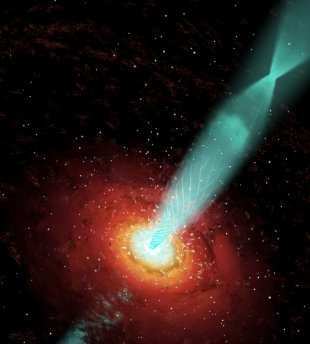
Researchers have obtained the clearest picture yet of the physics behind one of the most spectacular processes in the universe — huge bursts of light called blazars that are created as supermassive black holes suck in surrounding matter.
Using data from several different telescopes, the researchers identified a sequence of events whereby charged particles are accelerated and focussed by magnetic fields into a “jet” that blasts into space at 99% of the speed of light, creating a burst of light. Their findings appear to back up the existing theory of how jets form.
Lurking at the heart of many galaxies are supermassive black holes — hundreds of millions times heavier than the Sun — that pull nearby material into a relatively thin “accretion disk” that spirals inwards. As it does so, the material becomes very hot, forming a plasma of charged particles that creates magnetic field lines perpendicular to the plane of the disk.
Twisted nozzle
Astrophysicists believe that these magnetic field lines are twisted by the rotation of the disk to form a tight nozzle-like structure that points out from the centre of the accretion disk. The pressure within this nozzle is expected to be greatest closer to the black hole, and physicists believe this pressure difference along the nozzle drives some plasma away from accretion disk, creating a jet pointing out into space.
Blazar outbursts are thought to begin with a violent explosion near to the black hole, which sends a shockwave of energy through the nozzle. The twisted magnetic field lines are then thought to accelerate the shockwave and focus it into a tight “knot”. Because of the twisted nature of the magnetic field lines, the theory also predicts that the particles caught up in the knot will follow a spiral path as they are ejected.
Now, Alan Marscher and colleagues Boston University in the US along with an international group of collaborators are the first to catch a glimpse of this process. The team focused on a blazar at the centre of BL Lacertae, a galaxy some 950 million light years from Earth (Nature 452 966) . The blazar jet points almost directly at Earth and it fires intense bursts of radiation that last for several days and occur about once or twice a year.
Velocity measurement
The team focused on an outburst that occurred in late 2005. When the outburst emerged from the nozzle, its movement through space was tracked using the Very Long Baseline Array (VLBA) — which comprises ten radio telescopes spread across the US. This allowed the team to determine the velocity of the knot.
The behaviour of the outburst within the nozzle was studied using a number of optical, X-ray and gamma-ray telescopes — both ground-based and in space.
Using optical telescopes, the team saw a burst of light they believe was created when the knot reaches the point of maximum velocity in the nozzle. The presence of very high energy gamma rays in this burst suggests that at this point in time the plasma was being accelerated to velocities approaching the speed of light.
The time delay between the optical burst inside the nozzle and the radio burst outside the nozzle was measured. This was then multiplied by the velocity of the knot to get an idea of the length of the nozzle — which the team estimate to be about 1013 km or about 10,000 times the distance between the Earth and the Sun.
Rotating polarization
The team also found that the polarization of the light emitted from the knot rotated as the knot travelled through the nozzle. Mark Birkinshaw — an astrophysicists at the University of Bristol, UK, who was not involved in the research — told physicsworld.com that this is “consistent with the concept of a shocked structure moving along a helical magnetic field”. He added that Marscher’s findings “fit in nicely with most theories”.
According to Marscher, the team also gained some insight into what happens to the knot once it emerges from the nozzle. At this point, the team detected a second burst of high-energy gamma radiation, which they believe is related to the onset of turbulence in the flow of the plasma, which generates a great deal of heat and high-energy gamma rays.
One important question that the team was not able to answer however, is why the initial explosion occurs.
Marscher is now looking forward to gaining a better understanding of the gamma rays coming from blazars using NASA’s Gamma-ray Large Area Space Telescope (GLAST), which is expected to launch in May 2008. Further in the future a new radio telescope to be built in Japan in 2012 could be used in conjunction with the VLBA and other radio telescopes to peer more deeply into the nozzle of the jet.



